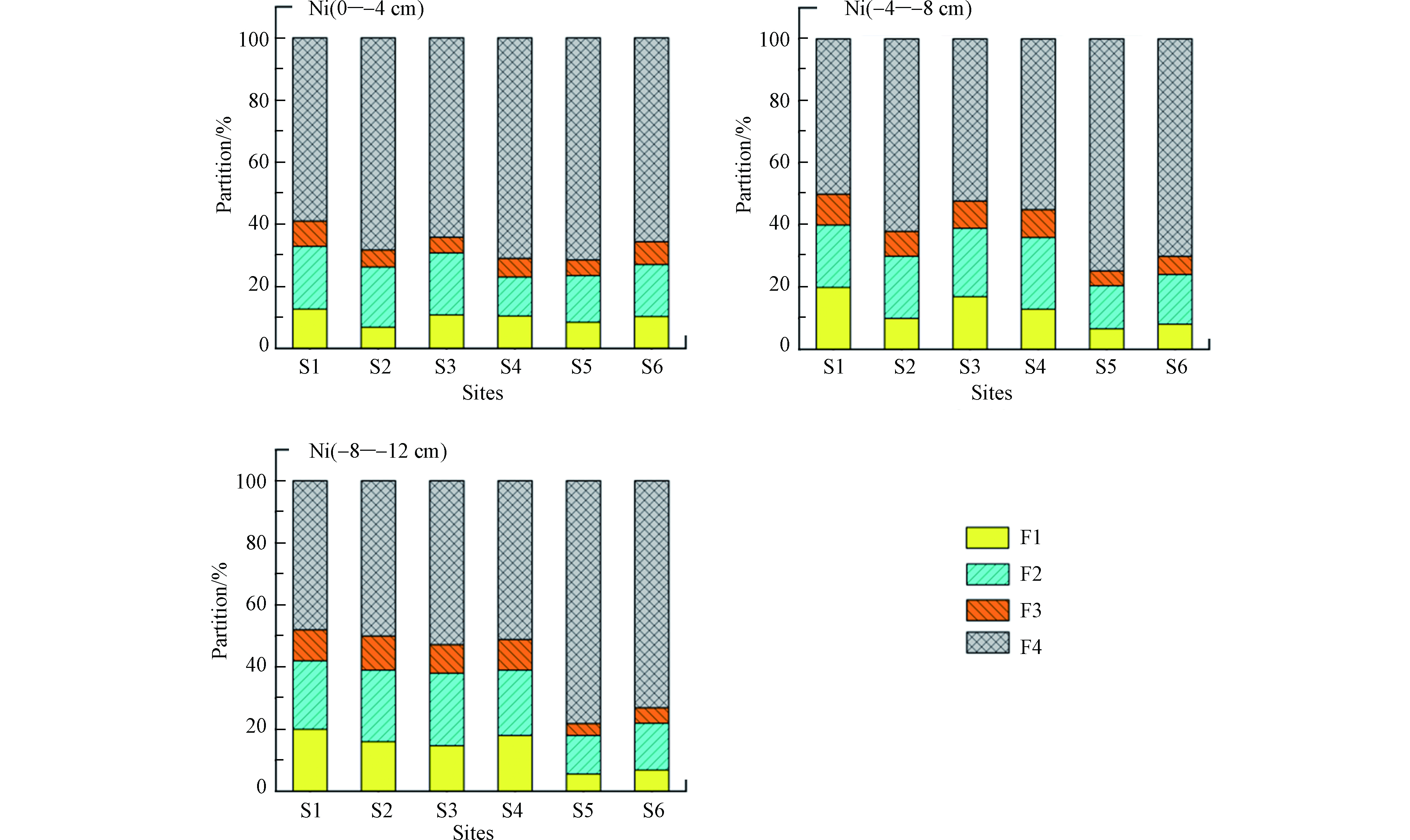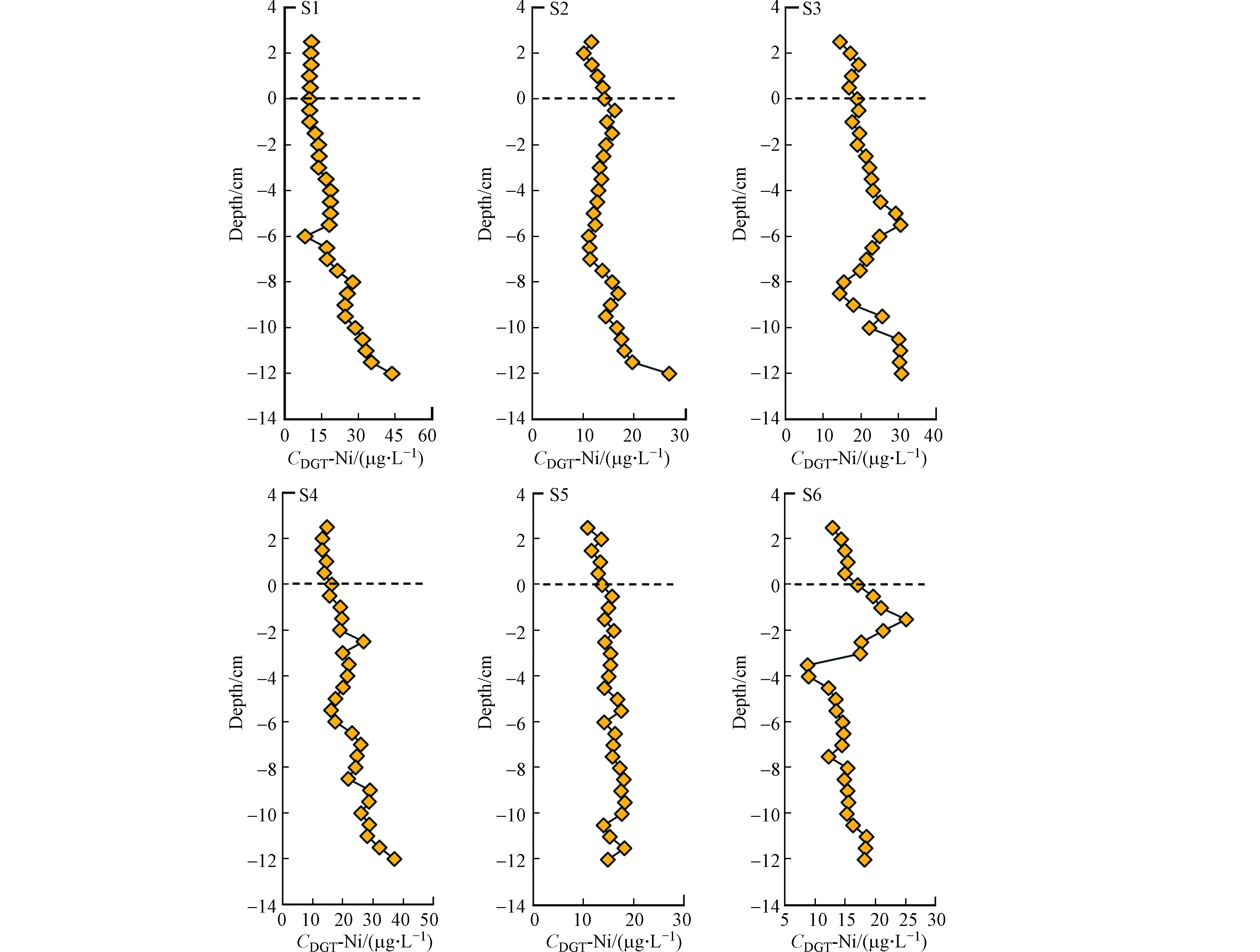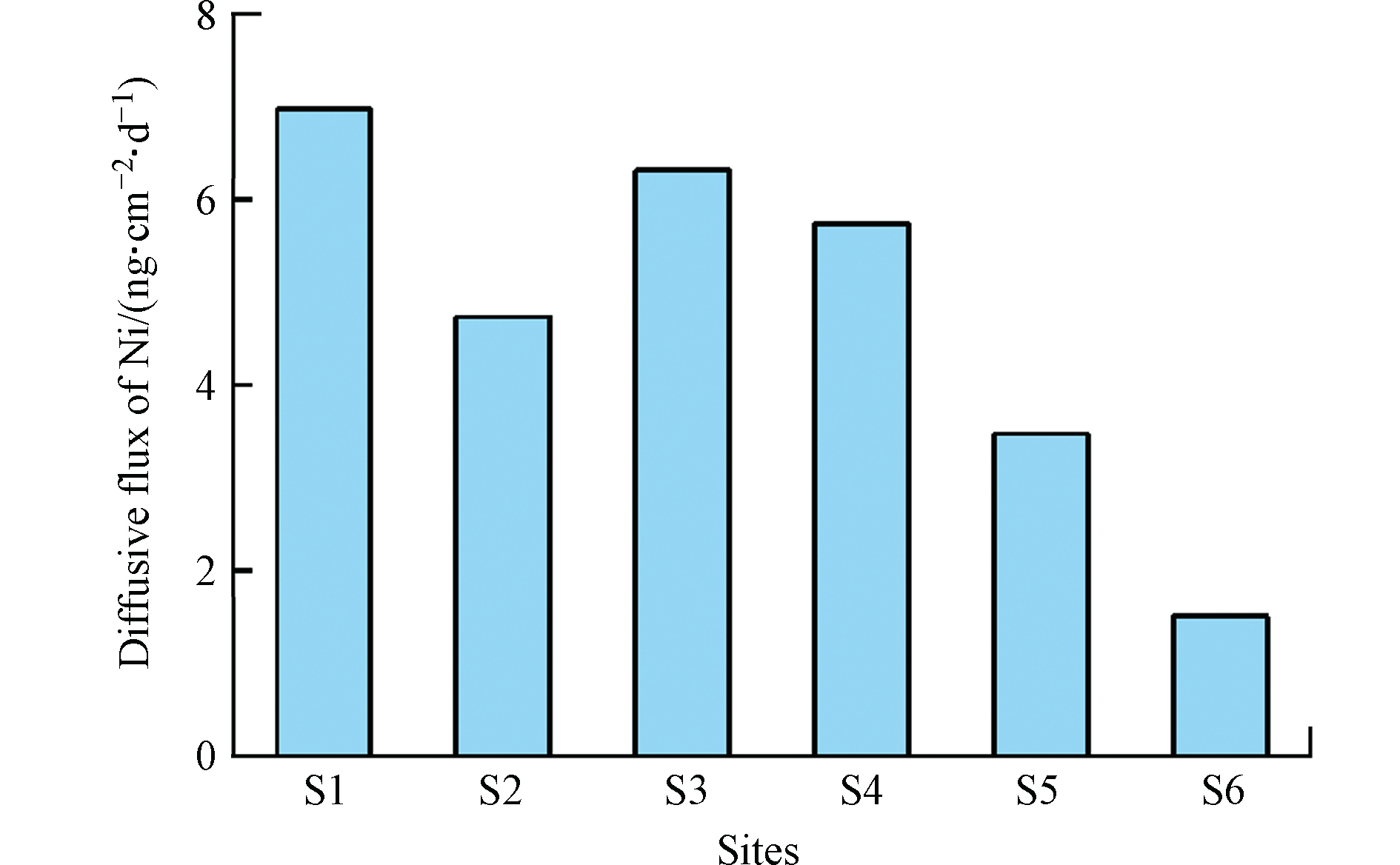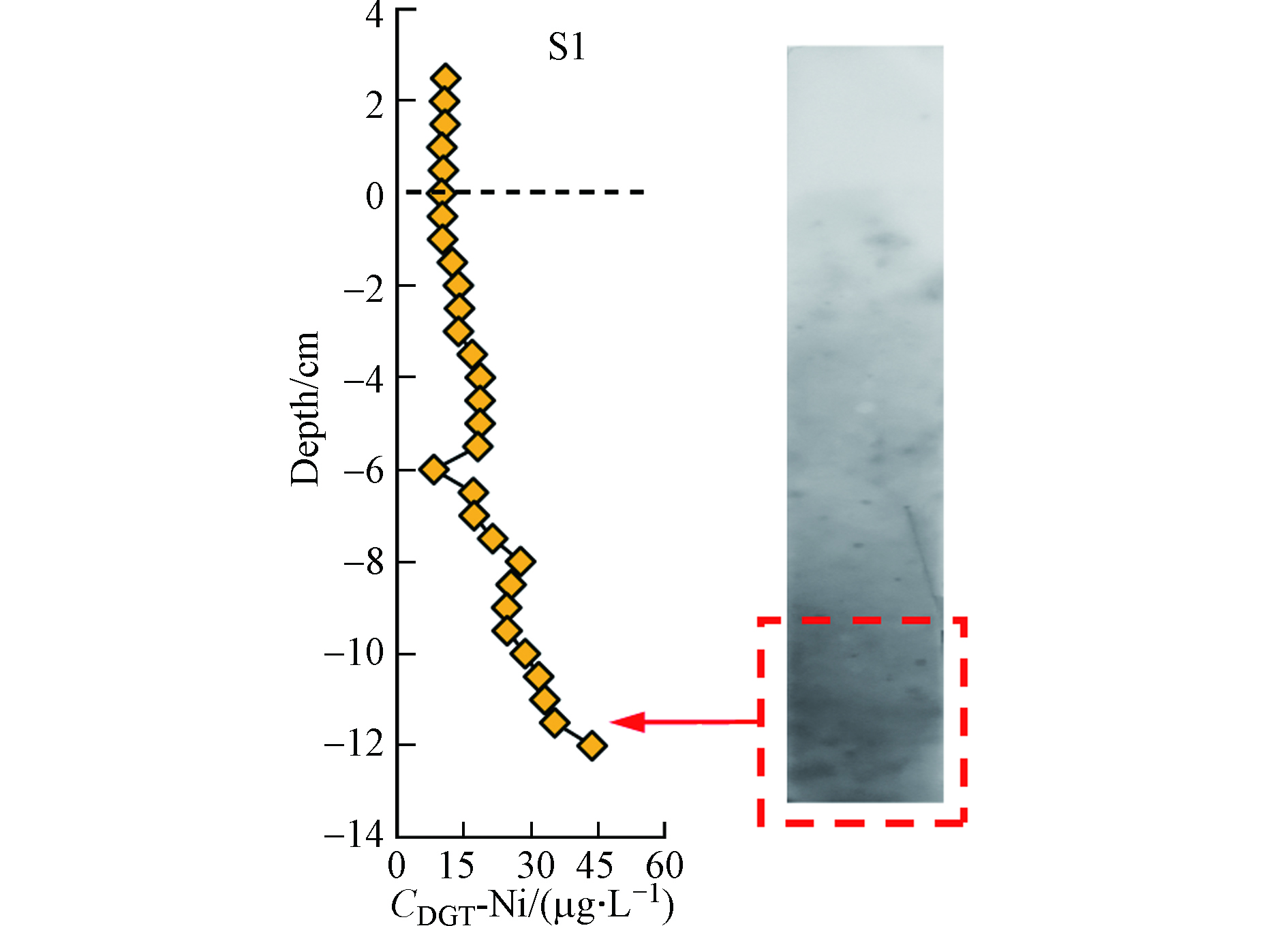-
镍(Ni)元素是人体及多数生物体所必需微量营养元素,但大量摄入对人体具有毒性[1]。在正常情况下,成人体内含镍约为10 mg,血液中正常浓度[2]为0.11 μg·mL−1,世界卫生组织国际癌症研究机构在2017年10月27日公布的初步整理参考致癌物清单中,镍化合物属于一类致癌物[3]。在水体中,Ni 主要通过沉淀和共沉淀等方式在沉积物中沉降,因此Ni在多数情况下主要富集在沉积物中[4]。但当水环境条件发生变化时(如pH或Eh),沉积物中吸附的镍又会向水体再次释放,进而造成水体的二次污染[5]。
沉积物重金属质量基准(sediment quality guidelines,SQGs)通常是指确保与沉积物表层的底栖生物或上覆水生物直接接触并不引起生物毒害效应的有害重金属元素危害的临界最高水平,也是重金属元素在沉积物中的最高允许含量,设置这样的基准可以反映重金属元素与底栖生物或上覆水生物之间的剂量-效应关系[6],它代表了底栖生物不发生不良生物效应时,沉积物中所允许重金属元素的最高含量[7-8]。近年来,国内学者针对不同地区的特点也采用不同沉积物质量基准法(SQGs)进行重金属污染的风险评价。沉积物重金属风险评价基准的阈值有很多,如陈云增等推算的滇池的重金属SQG值[9]以及邓保乐等推算的太湖沉积物质量基准(CSQC)推荐值[10],对流域沉积物中的重金属进行了生态风险评估。阳金希等同样利用生物效应数据库法对5种重金属(Cu、Cd、Pb、Zn、Ni)的淡水水体沉积物质量基准值[11],推算的中国淡水水体重金属SQG值。然而,近年来也有研究结果表明,单纯的利用总浓度不能反映沉积物中重金属的生物利用度和释放及迁移过程 [12] 。因此,对于沉积物重金属的形态及释放迁移过程需要结合其他方法来进一步评估和分析。
众多研究指出连续提取法(sequential extraction)可有效用于区分重金属的形态分析。目前国内外较为常用的连续提取方法为欧共体标准物质局在1992 年提出BCR连续提取技术,将重金属在沉积物中的存在状态划分为:弱酸提取态/可交换态(F1)、可还原态(F2)、可氧化态(F3)及残渣态(F4)4种。该方法虽然可以较好地分析沉积物中重金属形态特征,然而化学浸提方法仍是异位分析后而非原位的研究。若想更为明确地阐明原位重金属在沉积物与水相之间的再转移过程,需要结合具有能够微观表征重金属在沉积物-水界面(SWI, sediment-water interface)迁移转化的采样技术。薄膜扩散梯度技术(DGT, diffusive gradient in the thin films technique)于 1994 年由英国兰卡斯特大学的 Davison 和Zhang发明,用于测定溶液中微量金属的浓度[13]。该技术在原位重金属污染的环境监测和高分辨表征污染物有效态方面具有显著优势[14]。Søndergaard等[15]通过利用DGT表征锌铅矿附近的海洋底层沉积物中铅的生物有效性,发现DGT与部分藻类等指示性生物体内的铅吸收量呈现出高度的正相关(R2=0.79—0.94)。Schintu等[16]也在利用DGT技术评价地中海中贻贝中重金属含量的工作中发现了DGT测定的有效态铅镉与贻贝中铅镉含量呈现出高度相关。DGT采样器所积累的金属以通量的形式进行表示,反映了孔隙水浓度的变化,以及从沉积物到溶液的移动及再补给过程。DGT技术的主要优点是可以在亚毫米尺度上对垂直的沉积物进行微观观测[17]。Zhang等[18]通过对嘉陵江下游地区柱状沉积物取样分析后发现了Ni元素在5 mm的微观尺寸条件下从沉积物向水迁移的证据,其文中也指出了相比于传统方法,DGT技术在表征重金属在沉积物-水界面的迁移扩散过程具有原位和更加精准的优势。因此,利用DGT技术作为本研究中的环境监测手段对于进一步揭示镍元素在嘉陵江流域的垂向分布规律和迁移特征具有十分重要的意义。
嘉陵江目前是长江支流中流域面积最大、长度第三的河流,其干流流经陕西省、甘肃省、四川省及重庆市,在重庆市朝天门汇入长江。全长1345 km ,干流流域面积3.92万km2,总流域面积16万km2。嘉陵江的中上游地区流流经陕西省汉中市和四川省广元市。由于该地区长期的有色金属和煤矿的开采和冶炼史,随着矿区大量含有冲洗矿渣的废水向嘉陵江流域的排放,导致沉积物中的Ni的含量逐年增加,具有潜在的环境生态风险问题。因此,本文的主要利用连续提取法测定沉积物中Ni的形态分布,同时利用DGT技术分析镍在沉积物-水界面(SWI)的迁移特征,通过对二者结果的相关性比较分析,进一步探究在该研究区域内影响镍在沉积物中释放的因素。相关研究结果将为揭示镍元素在嘉陵江中上游流域的形态分布特征及其在沉积物水界面的迁移释放机制有十分重要的意义。
-
本研究区位于嘉陵江中下游(32°00′N—33°00′N,105°40′E—106°00′E),如图1所示研究中共设置6个采样点位(S1—S6),主要布置在有色金属矿区、煤矿区、采砂作业区和电子工业园附近(S1—S4)。此外选择两个受人为活动影响较小的山区采样点位(S5和S6)作为对照分析人为活动可能产生的影响。6个采样点具体为:汉中市宁强县燕子砭镇康宁街(S1);广元市朝天区朝天镇大巴口桥上游(S2);广元市利州区工农镇嘉陵江大桥(S3);广元市利州区盘龙镇袁家坝工业园(S4);广元市昭化区射箭乡昭化嘉陵江特大桥(S5);广元市昭化区射箭乡红岩嘉陵江大桥下(S6)。
利用沉积物柱状采样器在距离河岸边5—10 m的区域采集沉积物柱状样品,将6个所采的柱状样品取样后放置在河岸上,随后立即用氮气密封以防止氧化而将沉积柱放置在软内衬的黑盒中。将沉积柱顺利送达实验室后,把6个沉积柱在25 ℃的条件下平衡24 h后放入DGT探针进行试验。
-
沉积物质量基准法(Sediment quality guidelines)是评估沉积物中重金属污染的环境风险非常有力的方法。采取来源于现有沉积物化学及不良生物效应值的数据集[19]作为评估环境系统潜在风险的SQG值。采用沉积物中镍含量的总浓度与阈效应浓度(TEC)和可能效应浓度(PEC),同时选择国家水系沉积物重金属成分分析标准物质标准值(GBW07309和GBW07311)进行比较评价。该指标基于沉积物中镍含量的总浓度,当总镍浓度低于GBW07311及TEC值(低量程值)时,预计可能产生的影响极小或不会产生不利影响;若当总镍浓度高于GBW07309和及PEC值(高量程值)时,预计镍可能会对生态环境产生较为严重的影响。
-
在DGT探针放置结束并取出后,对沉积物层中的0至-12 cm分为3层(即每层4 cm)切片后分别对每个深度的沉积物样品进行连续提取实验。具体连续提取方法参照文献[20]。称取0.50 g的沉积物干燥样品进行实验,经过添加每一步所需溶液后提取得到重金属的3种形态:弱酸溶解态/可交换态(F1)、可还原态(F2)及可氧化态(F3),这一系列过程后产生了残渣态(F4),使用王水进行残渣态的酸消化。Ni总量的提取采用硝酸+氢氟酸+高氯酸的消解方法,具体操作参照Ščančar等[21]。待所有实验完成后,各个形态的滤液经电感耦合等离子体质谱仪(ICP-MS)进行分析得到数据。
-
本研究所采用DGT探针购买自DGT研究有限公司(Lancaster,UK)。DGT探针的窗口尺寸长度为150 mm,宽度为18 mm。DGT 装置由0.45μm过滤膜(纤维素-醋酸盐滤膜)、0.4 mm扩散膜(聚丙烯酰胺凝胶层)和吸附膜(Chelex-100作为重金属吸附相的凝胶)以及固定这 3 层膜的塑料外套组成。此外,将碘化银(AgI)扩散凝胶添加到DGT探针中,AgI扩散凝胶放置在Chelex-100凝胶之前一层,其可以与硫化物反应生成黑色Ag2S,即可进行溶解性硫化物的测量[22]。DGT探针被保存在温度为4 ℃的冰箱中。DGT探针放置方法参考文献[12]中所表述的试验方法进行。DGT放置实验在一个25 ℃黑暗的培养箱中进行。首先,用3 cm的水沉积物标签进行DGT探针标记,然后将DGT探针垂直插入沉积物柱中,放置24 h后回收DGT探针,将吸附凝胶用特氟纶涂层的刀片切成5 mm的垂直段,然后将吸附凝胶的切片转移到2 mL离心管中,加入1 mL 1 mol·L−1 HNO3溶液,进行重金属的洗脱,然后用ICP-MS进一步分析[18]。
目标重金属元素在凝胶上的累积质量(M)计算公式如下[13]:
式中,Ce为洗脱剂中金属的浓度;Vgel为结合胶的体积;Vacid为用于洗脱硝酸的体积(通常为1 mL); fe为洗脱因子,通常取0.8。
CDGT(平均浓度)的计算公式如下:
式中,Δg为扩散凝胶和滤膜厚度,cm;D为目标分析物的扩散系数,cm2·s−1;t为DGT放置时间,s;A为DGT采样窗口的面积,cm2。
-
沉积物-水界面(SWI)污染物的扩散通量是用来研究污染物释放风险的重要指标,可以表征污染物的释放方向及释放风险[23]。为了评价Ni的迁移过程,利用建立的数值模型[24],进行Ni在SWI上的表观扩散通量计算。基于该模型的方程如下[23]:
式中,F为Ni穿过界面的总通量;Fw为从水到SWI的不稳定Ni通量;Fs为从沉积物到SWI的不稳定Ni通量;
ϕ 为沉积物的孔隙度;Dw为Ni在上覆水中的基质比扩散系数;Ds为Ni在沉积物中的基质比扩散系数;(∂CDGT∂Xw)(x=0) 为上覆水体DGT浓度梯度;(∂CDGT∂Xs)(x=0) 为沉积物DGT浓度梯度。 -
利用Excel 2016进行数据统计与分析,利用Origin 2018 绘制重金属形态及含量图,采用SPSS 23.0进行重金属Ni、Fe和Mn的相关性分析,利用 ArcGIS 进行绘制采样点的分布图。每次实验开始前,所使用的所有玻璃器皿和岩心沉积物采样器皆在10%的HNO3中浸泡至少24 h,然后用超纯水进行处理。为了确保没有氧气进入到沉积物中,DGT探针的部署和沉积物柱的存储都在在厌氧手套箱(96% N2 / 4% H2)中进行。用标准物BCR-701作为沉积物质量控制样品,在整个提取过程中进行3个重复和空白样品的批量实验以保证实验结果的准确性。
-
6个位点表层沉积物中Ni的含量与4个不同基准限制值进行比较,结果如图2所示。由图2可见,所有位点的Ni总浓度大于GBW07311水平值;S1、S2、S3、S4、S6的Ni总浓度都大于TEC值,且S1、S2、S3、S4的Ni总浓度大于GBW07309水平值;S1的Ni总浓度为49.24 mg·kg−1大于TEC值。根据MacDonald等[25]所提出的评价标准,上述结果可以较为明确表明S5、S6位点沉积物中的Ni对当地水生生态系统产生不利影响的可能性较小,而S2、S3、S4位点沉积物中的Ni对当地的水生环境产生不利影响可能性较大,S1位点沉积物中的Ni对当地水生生态环境产生不利影响的可能性最大。综合SQGs评价的结果,表明所采样嘉陵江中下游范围的沉积物中镍污染而产生的毒性可能在当地水生生态系统中频繁发生。虽然S2、S3、S4位点的Ni含量没有超过PEC,但是均超过了我国的GBW07309限制值(32 mg·kg−1),说明这3个点位在我国的沉积物的环境基准限制条件范围内仍然是具有较高的环境风险。S1位点位于陕西省汉中市宁强县,该地区具有长时间的有色金属的开采历史,沿岸的大量的矿业废渣会直接排放至嘉陵江水体中,因而具有较大潜在生态风险,此外S2—S4位点均位于四川省广元市工业园区和生活区,广元市的煤炭、电力、机械等行业发展迅速,这也会导致嘉陵江流域的沉积物中Ni元素含量较高,而S5和S6两个点位位于较为人迹罕至的山区地区,缺少外源Ni元素人为输入的影响,因而Ni在S5和S6两个点位地区的浓度含量较低,环境风险明显小于前4个点位。
-
通过重金属元素总量对其环境风险评价在某种程度上可以提供基本的该地区不同位点污染风险的基本信息,但重金属污染物在环境中的赋存形态通常是决定其环境风险的关键因素。图3结果显示了Ni在沉积物中不同深度中主要存在形态,不论在0—−4 cm,−4—−8 cm,还是−8—−12 cm的沉积物中,F4-Ni为优势组成,即残渣态,Ni在各个深度中F4-Ni占总量平均分别为66.59% (0—−4 cm,下同),60.65%(−4—−8 cm)和58.85%(−8—−12 cm),其次为F2-Ni(不同深度平均占比分别为17.26%、19.13%和19.45%)、F1(不同深度平均占比分别为9.94%、12.46%和13.52%)。占比最少的为F3形态,不同深度的平均占比仅分别为6.22%、7.74%和8.16%。
F1-Ni(水溶态或酸可提取态)和F2-Ni(铁锰氧化物结合态)被认为是具有较高活性及可能存在潜在释放风险的形态,其可能受到Eh和pH的变化的影响[26]。在本研究中,表层沉积物中的(0—−4 cm)6个位点F1-Ni、F2-Ni中Ni的平均比例仅为9.94%、17.26%,根据Zhang等[27]中生态风险编码评价法的结果显示,F1形态占比低于10%的重金属含量通常表明该地区表层沉积物重金属毒性处于低风险状态。这结果表明在研究区域,尽管通过SQGs值比较后发现在S1—S4这4个点位总Ni含量较高的地区由于工矿业产生的含Ni废水进入到河流水环境后具有极高的环境风险,但Ni元素沉降到沉积物中可能大量结合生成了稳定的形态(硅酸盐相结合),因而本研究区域Ni的环境风险并不高,可能被生物体吸收的毒性形态相对较低。该结果也与Zhang等[18]在嘉陵江下游地区对Ni的形态分布结果相类似,其可能的主要原因是Ni与硅元素具有较强的亲和力,二者在环境中结合可能即会结合生成稳定结构物质[28]。但通过对比不同深度沉积物中Ni的形态分布结果仍然可以看出随着深度的增加,F1+F2+F3形态的镍占比含量也在逐渐增加,这表明一旦深层环境发生改变,深层沉积物存在Ni具有更容易释放的可能。该结果与Liu 等[29]和Yuan 等[30]研究结果基本一致。其结果表明在工业废水排放口附近点位采集的位点中F1-Ni,F2-Ni和F3-Ni随深度呈现出升高的趋势。但是在人烟稀少的山区采样位点S5和S6, 3种形态表现出降低的趋势,这与Tsai 等[31]的研究结果基本一致。其可能原因是与近年来当地政府对工矿区附近的沉积物底泥进行的频繁的清淤工程环境治理有关。这导致原本结构紧密的沉积物被清除,而上游冲击下来的泥沙结构堆积后结构本身不够稳定,通过河流水流作用下导致Ni更容易向深层沉积物迁移。而人烟稀少的山区附近底层沉积物长期未受扰动,沉积物结构较为紧密,阻碍了不同形态的Ni向下迁移的可能,导致表层沉积物中可提取的3种Ni形态的含量较高。
-
前述结果描述了Ni元素的总量及在沉积物中的形态分布特征,而分析Ni的垂直分布特征及其在环境中生物有效性对于评估污染物在沉积物及沉积物-水界面迁移及积累过程具有重要意义。图4中,S1、S2及S4 3个位点的CDGT-Ni垂直分布规律较为相似,从上覆水3 cm到-12 cm呈现缓慢波动增长趋势;S3点位的CDGT-Ni,从上覆水3 cm到1.5 cm有较明显增长趋势,后突然减少至17.56 μg·L−1,从1 cm到−5.5 cm呈现缓慢增长,随之递减至−8.5 cm处出现低峰值14.37 μg·L−1,波动增长至最大值30.80 μg·L−1;S5点位的CDGT-Ni垂直分布均匀,上覆水3 cm到−12 cm处在15.26 μg·L−1左右波动,基本保持稳定;S6点位从上覆水3 cm缓慢增长至−1.5 cm处达到峰值25.14 μg·L−1,随着沉积物深度增加,CDGT-Ni大幅度减少至−3.5 cm处低峰值8.80 μg·L−1,从−4.5 cm到−12 cm处波动小幅度增长至18.00 μg·L−1左右。
将DGT结果与连续提取结果进行结合比较及做相关性分析后,发现S1的可提取态含量最高(F1+F2+ F3),且S1的CDGT-Ni在6个位点中也是最高,随沉积物深度增加,CDGT-Ni值达到43.69 μg·L−1。由此可表明在连续提取过程中所提取部分是研究区域内通过DGT易于捕获的化学形态。这一结果与Roulier等[32]报道的其他重金属(镉、钴、铅)的相关结果一致。随着沉积物深度的增加,在还原条件下沉积物中Ni的积累可能受到铁、锰氧化物和含硫化合物等潜在因素的影响。Ni在沉积物中升高的趋势可能会导致沉积物中的Ni会通过沉积物-水界面向水体进行释放。
-
沉积物-水界面目标物的净扩散通量可以表征目标物的释放方向及释放风险[33]。因此为进一步证实Ni是否会通过沉积物水界面向水体释放,根据Fick扩散定律和DGT测得理论数据计算在Ni元素在各个点位的沉积物-水界面上扩散通量,可以进一步分析Ni在垂直空间所呈现的迁移特征及扩散规律,同时可以判断沉积物对于水体的潜在污染风险。如图5所示,正值代表Ni从沉积物向水中的扩散通量,DGT-Ni的扩散通量范围为1.51—6.97 ng·cm2·d−1,在所有位点通量均为正值,可说明6个位点Ni的迁移方向均为从沉积物向水体中迁移,由此可知研究区域沉积物中的Ni可以向上覆水迁移。S1位点的扩散通量值最高,S3、S4次之,说明S1点位中Ni从沉积物向上覆水的释放速度最快,同理S3、S4的释放速度相继次之,所呈现研究结果与DGT测得的结果基本一致,即S1点位中沉积物的DGT-Ni浓度高于S3、S4点位的沉积物,远高于其它3个位点的浓度。DGT及扩散通量分析结果表明S1、S3、S4处的水生生态系统比S2、S5、S6处更易受到Ni污染。
-
通过对不同深度沉积物连续提取的不同Ni形态与DGT对应的深度平均浓度进行相关性分析结果表明F1-Ni(酸可交换态)与DGT有效态具有明显相关性(表1)。前人研究中已经证明,这两种形态被广泛认为是生物利用分数高、最不稳定的形态[18, 28]。Zhang等[18]研究结果表明,沉积物中F1形态的重金属元素与DGT有效态重金属元素具有显著相关性[18],因此F1形态可能是导致有效态Ni在沉积物二次释放的潜在来源。
此外,相关性分析结果表明Ni元素释放与连续提取结果中F2(可还原态)中铁锰氧化物结合态Ni呈显著相关,因此推测铁(Fe)和锰(Mn)在沉积物中的变化可能是影响Ni在沉积物环境中二次释放的另一个关键因素。为进一步了解Fe、Mn对嘉陵江中游沉积物中Ni的迁移影响机理,对6个位点DGT有效态Fe、Mn和DGT有效态Ni 进行相关分析,结果如图6所示。由图6可知,DGT-Fe和DGT-Mn都与DGT-Ni呈现出显著正相关,该结果与Zhang等[18]在嘉陵江下游关于铅(Pb)、镉(Cd)和Ni研究结果十分相似。其主要原因是由于沉积物中铁、锰的氧化物(弱结晶态)在还原条件下的还原性溶解反应[27],引起了Fe、Mn离子与Ni离子同步释放的过程。报道中指出,在部分还原条件下的弱结晶态铁氧化物越多,DGT-Fe的浓度测量值就越多[34]。因此,在研究区域沉积物高度还原的条件下,水体中会释放更多的DGT-Fe,铁锰氧化物上所吸附的重金属Ni也会伴随Fe、Mn的释放而释放。
通过对表1中相关性结果进一步探究发现F3-Ni(可氧化态)也与DGT有效态Ni显著相关。F3形态通常为硫(S)与有机物相结合的形态,而S对于沉积物中重金属的移动性和毒性等方面具有较明显的控制作用[35]且研究证明Ni的生物利用性会受到沉积物中硫化物的显著影响[36],因此可以推测S也可能是影响Ni释放的一个重要因素。
在高度还原的沉积物环境中,金属阳离子通常与S2-结合,在沉积物中形成难溶的硫化物沉淀物。二价金属元素在还原条件下一般可以替代Fe在FeS中形成更加稳定的金属硫化物沉淀[36-37]反应如下:
在酸性挥发性硫(AVS)过量的沉积物中,由于重金属硫化物沉淀的产生,导致在沉积物的孔隙水中溶解的金属的浓度通常较低[35]。然而,一旦环境条件发生改变(如由于外界因素导致少量氧气进入)金属硫化物稳定结构会因此受到破坏导致重金属元素像环境中的二次释放。本研究所使用的DGT探针技术采用碘化银凝胶(凝胶中的AgI遇S元素会形成Ag2S的黑色沉淀物)来进一步揭示S是否会对Ni的二次释放有影响。选取DGT-Ni浓度最高的S1来研究DGT探针中硫化物含量,结果如图7,在底部约−9 cm—−12 cm处,可以明显观察到DGT-Ni浓度升高的“热点”区域与AgI凝胶在同一深度位置处出现明显的“黑色区域”同时出现。此结果表明,Ni和硫化物在底部沉积物存在同时释放。这一结果与之前发现S和重金属在−11 cm以下同时释放[38]的研究结果一致。
产生这种同步释放现象的主要原因可能由此嘉陵江流域的繁荣采砂业和政府的清淤工程对水体中稳定沉积物的氧化还原状态的一个破坏。采砂对沉积物底泥形貌结构发生破坏后,导致氧气进入到沉积物中。由于采样地区位于广元山区地带,上游流速较快的河流可以将大量泥沙较快冲击下来导致可能有部分氧气被储存在被挖沙破坏结构的深层沉积物的微孔结构中。由于氧气的介入,可导致反应(6)的发生,其中硫化物可作为电子供体[39],发生氧化反应,从而破坏稳定硫化物沉淀的结构[35]。该反应中所释放出的SO42-可以被厌氧微生物的进一步作用还原成S2-,从而被碘化银凝胶而捕捉而形成黑色印记。因此,上述过程可能是S调控Ni在沉积物中同步释放的机制。
-
(1)对比表层沉积物中总Ni含量与几种水系沉积物质量基准值和我国沉积标准物质中Ni的浓度值发现Ni在所采样区域的浓度均大于基础评价基准值,部分点位甚至超过高基准值,由此推测沉积物中镍污染产生的毒性可能在当地水生生态系统中较频繁发生。
(2)通过对沉积物的Ni形态分布进一步的分析结果表明,Ni在沉积物中主要以残渣态存在。Ni在研究区域沉积物中实际环境风险并不高,可能被生物体吸收的毒性形态浓度相对较低。
(3)采用DGT技术测定Ni在沉积物的垂向分布特征,发现Ni几乎在所有点位的深层沉积物中出现了二次释放的过程。进一步对Ni在SWI扩散通量的计算分析发现所有采样点位中Ni均存在从沉积物向上覆水迁移的趋势,表明研究区域中水生生态系统潜在受到沉积物中Ni污染的可能。
(4)通过对连续提取各形态Ni与DGT的相关性分析发现,沉积物中Ni的二次释放过程可能受到铁、锰氧化物和含硫化合物等因素的控制。
嘉陵江中上游段沉积物中镍的形态分布及其在沉积物-水界面迁移特征
The study of Ni fraction in the sediment and mitigation characteristics of Ni cross the sediment-water interface in the mid-upstream of Jialing River
-
摘要: 本研究使用沉积物柱状采样器对嘉陵江中上游废弃工矿区附近的沉积物进行采样,利用连续提取法和薄膜扩散梯度技术(diffusive gradient in the thin film technique, DGT)研究嘉陵江中上游段沉积物中镍元素(Ni)的在沉积物中赋存形态及其在沉积物-水界面的迁移扩散规律和释放机制。结果表明,各样点表层沉积物中总Ni含量均超过了我国水系沉积物的低标准物质值(GBW07311, 14.3 mg·kg−1),并有3个工矿区附近的点位超过了高标准物质值(GBW07309, 32 mg·kg−1),表明曾经的工矿作业等人为活动所引起的含Ni废水排放已经对当地水生生态系统构成严重的威胁。但连续提取各位点的主要存在形态为残渣态(F4),而最弱的结合态(F1,酸可交换态)的在所有采样点位的平均占比不足10%表明Ni对周边水体生态系统的实际环境风险可能并不高。DGT结果显示,CDGT-Ni浓度在S1和S2点位的深层沉积物(−9 cm—−12 cm)显著升高,在这两个采样点位表现出明显的释放趋势。通过对Ni在沉积物-水界面的扩散通量进一步计算发现Ni具有潜在内源释放风险,具有从沉积物向水的迁移趋势,会对研究区域水体形成潜在的污染。通过对连续提取中Ni的各个形态与DGT有效态Ni相关性分析发现沉积物中Ni在深层沉积物的释放过程主要受到铁、锰氧化物和含硫化合物等潜在因素的影响。Abstract: This study used sediment core samplers to collect core sediments near the region of abandoned industrial mine along the mid-upstream of Jialing River. The fraction of Ni in the sediment was studied by sequential extraction. The mitigation characteristics and release mechanism of Ni at the sediment water interface (SWI) were analyzed by diffusive gradient in the thin films technique (DGT). The results showed that total concentration of Ni in all sites exceeded the low sediment reference material (GBW07311, 14.3 mg·kg−1) of China and three sites near the mining areas even exceeded high sediment reference material (GBW07309, 32 mg·kg−1). This indicates that Ni contained effluent discharged by past mining industry and other anthropogenic activities may pose a serious environment risk to aquatic ecosystem. However, the main fraction of Ni was bounded in residue fraction while the acid/changeable fraction was no more than average 10%, which indicated that Ni had little environmental risk to local water ecosystem. DGT results showed that CDGT-Ni significantly increased at the bottom sediment (−9 cm to −12 cm) presenting an obvious release trend at this depth. Further calculation of Ni diffusion flux at the sediment water interface shows that Ni can be released into the sediment and pass through sediment-water interface, which will cause potential pollution of overlying water. The correlation analysis between the different Ni fractions and DGT labile Ni shows that the release process of Ni in deep sediment was mainly controlled by potential factors such as iron, manganese oxides and sulfur compounds.
-
Key words:
- sediment /
- nickel /
- sequential extraction /
- DGT /
- Jialing River
-
镍(Ni)元素是人体及多数生物体所必需微量营养元素,但大量摄入对人体具有毒性[1]。在正常情况下,成人体内含镍约为10 mg,血液中正常浓度[2]为0.11 μg·mL−1,世界卫生组织国际癌症研究机构在2017年10月27日公布的初步整理参考致癌物清单中,镍化合物属于一类致癌物[3]。在水体中,Ni 主要通过沉淀和共沉淀等方式在沉积物中沉降,因此Ni在多数情况下主要富集在沉积物中[4]。但当水环境条件发生变化时(如pH或Eh),沉积物中吸附的镍又会向水体再次释放,进而造成水体的二次污染[5]。
沉积物重金属质量基准(sediment quality guidelines,SQGs)通常是指确保与沉积物表层的底栖生物或上覆水生物直接接触并不引起生物毒害效应的有害重金属元素危害的临界最高水平,也是重金属元素在沉积物中的最高允许含量,设置这样的基准可以反映重金属元素与底栖生物或上覆水生物之间的剂量-效应关系[6],它代表了底栖生物不发生不良生物效应时,沉积物中所允许重金属元素的最高含量[7-8]。近年来,国内学者针对不同地区的特点也采用不同沉积物质量基准法(SQGs)进行重金属污染的风险评价。沉积物重金属风险评价基准的阈值有很多,如陈云增等推算的滇池的重金属SQG值[9]以及邓保乐等推算的太湖沉积物质量基准(CSQC)推荐值[10],对流域沉积物中的重金属进行了生态风险评估。阳金希等同样利用生物效应数据库法对5种重金属(Cu、Cd、Pb、Zn、Ni)的淡水水体沉积物质量基准值[11],推算的中国淡水水体重金属SQG值。然而,近年来也有研究结果表明,单纯的利用总浓度不能反映沉积物中重金属的生物利用度和释放及迁移过程 [12] 。因此,对于沉积物重金属的形态及释放迁移过程需要结合其他方法来进一步评估和分析。
众多研究指出连续提取法(sequential extraction)可有效用于区分重金属的形态分析。目前国内外较为常用的连续提取方法为欧共体标准物质局在1992 年提出BCR连续提取技术,将重金属在沉积物中的存在状态划分为:弱酸提取态/可交换态(F1)、可还原态(F2)、可氧化态(F3)及残渣态(F4)4种。该方法虽然可以较好地分析沉积物中重金属形态特征,然而化学浸提方法仍是异位分析后而非原位的研究。若想更为明确地阐明原位重金属在沉积物与水相之间的再转移过程,需要结合具有能够微观表征重金属在沉积物-水界面(SWI, sediment-water interface)迁移转化的采样技术。薄膜扩散梯度技术(DGT, diffusive gradient in the thin films technique)于 1994 年由英国兰卡斯特大学的 Davison 和Zhang发明,用于测定溶液中微量金属的浓度[13]。该技术在原位重金属污染的环境监测和高分辨表征污染物有效态方面具有显著优势[14]。Søndergaard等[15]通过利用DGT表征锌铅矿附近的海洋底层沉积物中铅的生物有效性,发现DGT与部分藻类等指示性生物体内的铅吸收量呈现出高度的正相关(R2=0.79—0.94)。Schintu等[16]也在利用DGT技术评价地中海中贻贝中重金属含量的工作中发现了DGT测定的有效态铅镉与贻贝中铅镉含量呈现出高度相关。DGT采样器所积累的金属以通量的形式进行表示,反映了孔隙水浓度的变化,以及从沉积物到溶液的移动及再补给过程。DGT技术的主要优点是可以在亚毫米尺度上对垂直的沉积物进行微观观测[17]。Zhang等[18]通过对嘉陵江下游地区柱状沉积物取样分析后发现了Ni元素在5 mm的微观尺寸条件下从沉积物向水迁移的证据,其文中也指出了相比于传统方法,DGT技术在表征重金属在沉积物-水界面的迁移扩散过程具有原位和更加精准的优势。因此,利用DGT技术作为本研究中的环境监测手段对于进一步揭示镍元素在嘉陵江流域的垂向分布规律和迁移特征具有十分重要的意义。
嘉陵江目前是长江支流中流域面积最大、长度第三的河流,其干流流经陕西省、甘肃省、四川省及重庆市,在重庆市朝天门汇入长江。全长1345 km ,干流流域面积3.92万km2,总流域面积16万km2。嘉陵江的中上游地区流流经陕西省汉中市和四川省广元市。由于该地区长期的有色金属和煤矿的开采和冶炼史,随着矿区大量含有冲洗矿渣的废水向嘉陵江流域的排放,导致沉积物中的Ni的含量逐年增加,具有潜在的环境生态风险问题。因此,本文的主要利用连续提取法测定沉积物中Ni的形态分布,同时利用DGT技术分析镍在沉积物-水界面(SWI)的迁移特征,通过对二者结果的相关性比较分析,进一步探究在该研究区域内影响镍在沉积物中释放的因素。相关研究结果将为揭示镍元素在嘉陵江中上游流域的形态分布特征及其在沉积物水界面的迁移释放机制有十分重要的意义。
1. 材料及方法(Materials and methods)
1.1 研究区介绍及样本采集
本研究区位于嘉陵江中下游(32°00′N—33°00′N,105°40′E—106°00′E),如图1所示研究中共设置6个采样点位(S1—S6),主要布置在有色金属矿区、煤矿区、采砂作业区和电子工业园附近(S1—S4)。此外选择两个受人为活动影响较小的山区采样点位(S5和S6)作为对照分析人为活动可能产生的影响。6个采样点具体为:汉中市宁强县燕子砭镇康宁街(S1);广元市朝天区朝天镇大巴口桥上游(S2);广元市利州区工农镇嘉陵江大桥(S3);广元市利州区盘龙镇袁家坝工业园(S4);广元市昭化区射箭乡昭化嘉陵江特大桥(S5);广元市昭化区射箭乡红岩嘉陵江大桥下(S6)。
利用沉积物柱状采样器在距离河岸边5—10 m的区域采集沉积物柱状样品,将6个所采的柱状样品取样后放置在河岸上,随后立即用氮气密封以防止氧化而将沉积柱放置在软内衬的黑盒中。将沉积柱顺利送达实验室后,把6个沉积柱在25 ℃的条件下平衡24 h后放入DGT探针进行试验。
1.2 研究方法及数据分析
1.2.1 沉积物质量基准值(SQGs)
沉积物质量基准法(Sediment quality guidelines)是评估沉积物中重金属污染的环境风险非常有力的方法。采取来源于现有沉积物化学及不良生物效应值的数据集[19]作为评估环境系统潜在风险的SQG值。采用沉积物中镍含量的总浓度与阈效应浓度(TEC)和可能效应浓度(PEC),同时选择国家水系沉积物重金属成分分析标准物质标准值(GBW07309和GBW07311)进行比较评价。该指标基于沉积物中镍含量的总浓度,当总镍浓度低于GBW07311及TEC值(低量程值)时,预计可能产生的影响极小或不会产生不利影响;若当总镍浓度高于GBW07309和及PEC值(高量程值)时,预计镍可能会对生态环境产生较为严重的影响。
1.2.2 BCR连续提取法及酸消化法
在DGT探针放置结束并取出后,对沉积物层中的0至-12 cm分为3层(即每层4 cm)切片后分别对每个深度的沉积物样品进行连续提取实验。具体连续提取方法参照文献[20]。称取0.50 g的沉积物干燥样品进行实验,经过添加每一步所需溶液后提取得到重金属的3种形态:弱酸溶解态/可交换态(F1)、可还原态(F2)及可氧化态(F3),这一系列过程后产生了残渣态(F4),使用王水进行残渣态的酸消化。Ni总量的提取采用硝酸+氢氟酸+高氯酸的消解方法,具体操作参照Ščančar等[21]。待所有实验完成后,各个形态的滤液经电感耦合等离子体质谱仪(ICP-MS)进行分析得到数据。
1.2.3 DGT的放置、洗脱和计算
本研究所采用DGT探针购买自DGT研究有限公司(Lancaster,UK)。DGT探针的窗口尺寸长度为150 mm,宽度为18 mm。DGT 装置由0.45μm过滤膜(纤维素-醋酸盐滤膜)、0.4 mm扩散膜(聚丙烯酰胺凝胶层)和吸附膜(Chelex-100作为重金属吸附相的凝胶)以及固定这 3 层膜的塑料外套组成。此外,将碘化银(AgI)扩散凝胶添加到DGT探针中,AgI扩散凝胶放置在Chelex-100凝胶之前一层,其可以与硫化物反应生成黑色Ag2S,即可进行溶解性硫化物的测量[22]。DGT探针被保存在温度为4 ℃的冰箱中。DGT探针放置方法参考文献[12]中所表述的试验方法进行。DGT放置实验在一个25 ℃黑暗的培养箱中进行。首先,用3 cm的水沉积物标签进行DGT探针标记,然后将DGT探针垂直插入沉积物柱中,放置24 h后回收DGT探针,将吸附凝胶用特氟纶涂层的刀片切成5 mm的垂直段,然后将吸附凝胶的切片转移到2 mL离心管中,加入1 mL 1 mol·L−1 HNO3溶液,进行重金属的洗脱,然后用ICP-MS进一步分析[18]。
目标重金属元素在凝胶上的累积质量(M)计算公式如下[13]:
M=Ce(Vgel+Vacid)fe (1) 式中,Ce为洗脱剂中金属的浓度;Vgel为结合胶的体积;Vacid为用于洗脱硝酸的体积(通常为1 mL); fe为洗脱因子,通常取0.8。
CDGT(平均浓度)的计算公式如下:
CDGT=MΔgDtA (2) 式中,Δg为扩散凝胶和滤膜厚度,cm;D为目标分析物的扩散系数,cm2·s−1;t为DGT放置时间,s;A为DGT采样窗口的面积,cm2。
1.2.4 扩散通量计算
沉积物-水界面(SWI)污染物的扩散通量是用来研究污染物释放风险的重要指标,可以表征污染物的释放方向及释放风险[23]。为了评价Ni的迁移过程,利用建立的数值模型[24],进行Ni在SWI上的表观扩散通量计算。基于该模型的方程如下[23]:
F=Fw+Fs=Dw(∂CDGT∂XW)(x=0)+ϕDS(∂CDGT∂Xs)(x=0) (3) 式中,F为Ni穿过界面的总通量;Fw为从水到SWI的不稳定Ni通量;Fs为从沉积物到SWI的不稳定Ni通量;
ϕ (∂CDGT∂Xw)(x=0) (∂CDGT∂Xs)(x=0) 1.2.5 数据分析及实验参数质量控制
利用Excel 2016进行数据统计与分析,利用Origin 2018 绘制重金属形态及含量图,采用SPSS 23.0进行重金属Ni、Fe和Mn的相关性分析,利用 ArcGIS 进行绘制采样点的分布图。每次实验开始前,所使用的所有玻璃器皿和岩心沉积物采样器皆在10%的HNO3中浸泡至少24 h,然后用超纯水进行处理。为了确保没有氧气进入到沉积物中,DGT探针的部署和沉积物柱的存储都在在厌氧手套箱(96% N2 / 4% H2)中进行。用标准物BCR-701作为沉积物质量控制样品,在整个提取过程中进行3个重复和空白样品的批量实验以保证实验结果的准确性。
2. 结果与讨论(Results and discussion)
2.1 Ni总浓度与沉积物质量基准值的比较分析与空间分布特征
6个位点表层沉积物中Ni的含量与4个不同基准限制值进行比较,结果如图2所示。由图2可见,所有位点的Ni总浓度大于GBW07311水平值;S1、S2、S3、S4、S6的Ni总浓度都大于TEC值,且S1、S2、S3、S4的Ni总浓度大于GBW07309水平值;S1的Ni总浓度为49.24 mg·kg−1大于TEC值。根据MacDonald等[25]所提出的评价标准,上述结果可以较为明确表明S5、S6位点沉积物中的Ni对当地水生生态系统产生不利影响的可能性较小,而S2、S3、S4位点沉积物中的Ni对当地的水生环境产生不利影响可能性较大,S1位点沉积物中的Ni对当地水生生态环境产生不利影响的可能性最大。综合SQGs评价的结果,表明所采样嘉陵江中下游范围的沉积物中镍污染而产生的毒性可能在当地水生生态系统中频繁发生。虽然S2、S3、S4位点的Ni含量没有超过PEC,但是均超过了我国的GBW07309限制值(32 mg·kg−1),说明这3个点位在我国的沉积物的环境基准限制条件范围内仍然是具有较高的环境风险。S1位点位于陕西省汉中市宁强县,该地区具有长时间的有色金属的开采历史,沿岸的大量的矿业废渣会直接排放至嘉陵江水体中,因而具有较大潜在生态风险,此外S2—S4位点均位于四川省广元市工业园区和生活区,广元市的煤炭、电力、机械等行业发展迅速,这也会导致嘉陵江流域的沉积物中Ni元素含量较高,而S5和S6两个点位位于较为人迹罕至的山区地区,缺少外源Ni元素人为输入的影响,因而Ni在S5和S6两个点位地区的浓度含量较低,环境风险明显小于前4个点位。
2.2 表层沉积物中的Ni形态分析特征
通过重金属元素总量对其环境风险评价在某种程度上可以提供基本的该地区不同位点污染风险的基本信息,但重金属污染物在环境中的赋存形态通常是决定其环境风险的关键因素。图3结果显示了Ni在沉积物中不同深度中主要存在形态,不论在0—−4 cm,−4—−8 cm,还是−8—−12 cm的沉积物中,F4-Ni为优势组成,即残渣态,Ni在各个深度中F4-Ni占总量平均分别为66.59% (0—−4 cm,下同),60.65%(−4—−8 cm)和58.85%(−8—−12 cm),其次为F2-Ni(不同深度平均占比分别为17.26%、19.13%和19.45%)、F1(不同深度平均占比分别为9.94%、12.46%和13.52%)。占比最少的为F3形态,不同深度的平均占比仅分别为6.22%、7.74%和8.16%。
F1-Ni(水溶态或酸可提取态)和F2-Ni(铁锰氧化物结合态)被认为是具有较高活性及可能存在潜在释放风险的形态,其可能受到Eh和pH的变化的影响[26]。在本研究中,表层沉积物中的(0—−4 cm)6个位点F1-Ni、F2-Ni中Ni的平均比例仅为9.94%、17.26%,根据Zhang等[27]中生态风险编码评价法的结果显示,F1形态占比低于10%的重金属含量通常表明该地区表层沉积物重金属毒性处于低风险状态。这结果表明在研究区域,尽管通过SQGs值比较后发现在S1—S4这4个点位总Ni含量较高的地区由于工矿业产生的含Ni废水进入到河流水环境后具有极高的环境风险,但Ni元素沉降到沉积物中可能大量结合生成了稳定的形态(硅酸盐相结合),因而本研究区域Ni的环境风险并不高,可能被生物体吸收的毒性形态相对较低。该结果也与Zhang等[18]在嘉陵江下游地区对Ni的形态分布结果相类似,其可能的主要原因是Ni与硅元素具有较强的亲和力,二者在环境中结合可能即会结合生成稳定结构物质[28]。但通过对比不同深度沉积物中Ni的形态分布结果仍然可以看出随着深度的增加,F1+F2+F3形态的镍占比含量也在逐渐增加,这表明一旦深层环境发生改变,深层沉积物存在Ni具有更容易释放的可能。该结果与Liu 等[29]和Yuan 等[30]研究结果基本一致。其结果表明在工业废水排放口附近点位采集的位点中F1-Ni,F2-Ni和F3-Ni随深度呈现出升高的趋势。但是在人烟稀少的山区采样位点S5和S6, 3种形态表现出降低的趋势,这与Tsai 等[31]的研究结果基本一致。其可能原因是与近年来当地政府对工矿区附近的沉积物底泥进行的频繁的清淤工程环境治理有关。这导致原本结构紧密的沉积物被清除,而上游冲击下来的泥沙结构堆积后结构本身不够稳定,通过河流水流作用下导致Ni更容易向深层沉积物迁移。而人烟稀少的山区附近底层沉积物长期未受扰动,沉积物结构较为紧密,阻碍了不同形态的Ni向下迁移的可能,导致表层沉积物中可提取的3种Ni形态的含量较高。
2.3 沉积物水界面附近DGT-Ni垂向分布分析
前述结果描述了Ni元素的总量及在沉积物中的形态分布特征,而分析Ni的垂直分布特征及其在环境中生物有效性对于评估污染物在沉积物及沉积物-水界面迁移及积累过程具有重要意义。图4中,S1、S2及S4 3个位点的CDGT-Ni垂直分布规律较为相似,从上覆水3 cm到-12 cm呈现缓慢波动增长趋势;S3点位的CDGT-Ni,从上覆水3 cm到1.5 cm有较明显增长趋势,后突然减少至17.56 μg·L−1,从1 cm到−5.5 cm呈现缓慢增长,随之递减至−8.5 cm处出现低峰值14.37 μg·L−1,波动增长至最大值30.80 μg·L−1;S5点位的CDGT-Ni垂直分布均匀,上覆水3 cm到−12 cm处在15.26 μg·L−1左右波动,基本保持稳定;S6点位从上覆水3 cm缓慢增长至−1.5 cm处达到峰值25.14 μg·L−1,随着沉积物深度增加,CDGT-Ni大幅度减少至−3.5 cm处低峰值8.80 μg·L−1,从−4.5 cm到−12 cm处波动小幅度增长至18.00 μg·L−1左右。
将DGT结果与连续提取结果进行结合比较及做相关性分析后,发现S1的可提取态含量最高(F1+F2+ F3),且S1的CDGT-Ni在6个位点中也是最高,随沉积物深度增加,CDGT-Ni值达到43.69 μg·L−1。由此可表明在连续提取过程中所提取部分是研究区域内通过DGT易于捕获的化学形态。这一结果与Roulier等[32]报道的其他重金属(镉、钴、铅)的相关结果一致。随着沉积物深度的增加,在还原条件下沉积物中Ni的积累可能受到铁、锰氧化物和含硫化合物等潜在因素的影响。Ni在沉积物中升高的趋势可能会导致沉积物中的Ni会通过沉积物-水界面向水体进行释放。
2.4 Ni在沉积物-水界面扩散通量分析
沉积物-水界面目标物的净扩散通量可以表征目标物的释放方向及释放风险[33]。因此为进一步证实Ni是否会通过沉积物水界面向水体释放,根据Fick扩散定律和DGT测得理论数据计算在Ni元素在各个点位的沉积物-水界面上扩散通量,可以进一步分析Ni在垂直空间所呈现的迁移特征及扩散规律,同时可以判断沉积物对于水体的潜在污染风险。如图5所示,正值代表Ni从沉积物向水中的扩散通量,DGT-Ni的扩散通量范围为1.51—6.97 ng·cm2·d−1,在所有位点通量均为正值,可说明6个位点Ni的迁移方向均为从沉积物向水体中迁移,由此可知研究区域沉积物中的Ni可以向上覆水迁移。S1位点的扩散通量值最高,S3、S4次之,说明S1点位中Ni从沉积物向上覆水的释放速度最快,同理S3、S4的释放速度相继次之,所呈现研究结果与DGT测得的结果基本一致,即S1点位中沉积物的DGT-Ni浓度高于S3、S4点位的沉积物,远高于其它3个位点的浓度。DGT及扩散通量分析结果表明S1、S3、S4处的水生生态系统比S2、S5、S6处更易受到Ni污染。
2.5 引起Ni在沉积物中二次释放因素分析
通过对不同深度沉积物连续提取的不同Ni形态与DGT对应的深度平均浓度进行相关性分析结果表明F1-Ni(酸可交换态)与DGT有效态具有明显相关性(表1)。前人研究中已经证明,这两种形态被广泛认为是生物利用分数高、最不稳定的形态[18, 28]。Zhang等[18]研究结果表明,沉积物中F1形态的重金属元素与DGT有效态重金属元素具有显著相关性[18],因此F1形态可能是导致有效态Ni在沉积物二次释放的潜在来源。
表 1 DGT有效态镍与几种连续提取形态的镍相关性分析Table 1. Correlation analysis of DGT available nickel and several continuous extraction forms of nickelF1-Ni F2-Ni F3-Ni F1-Ni+F2-Ni F1-Ni+F2-Ni+F3-Ni CDGT-Ni 0.844** 0.719* 0.733* 0.746* 0.683* 注:** 表示在 P<0.01水平上极显著相关; * 在p<0.05水平上显著相关. Note: ** Correlation is significant at 0.01 level; * Correlation is significant at 0.05 level. 此外,相关性分析结果表明Ni元素释放与连续提取结果中F2(可还原态)中铁锰氧化物结合态Ni呈显著相关,因此推测铁(Fe)和锰(Mn)在沉积物中的变化可能是影响Ni在沉积物环境中二次释放的另一个关键因素。为进一步了解Fe、Mn对嘉陵江中游沉积物中Ni的迁移影响机理,对6个位点DGT有效态Fe、Mn和DGT有效态Ni 进行相关分析,结果如图6所示。由图6可知,DGT-Fe和DGT-Mn都与DGT-Ni呈现出显著正相关,该结果与Zhang等[18]在嘉陵江下游关于铅(Pb)、镉(Cd)和Ni研究结果十分相似。其主要原因是由于沉积物中铁、锰的氧化物(弱结晶态)在还原条件下的还原性溶解反应[27],引起了Fe、Mn离子与Ni离子同步释放的过程。报道中指出,在部分还原条件下的弱结晶态铁氧化物越多,DGT-Fe的浓度测量值就越多[34]。因此,在研究区域沉积物高度还原的条件下,水体中会释放更多的DGT-Fe,铁锰氧化物上所吸附的重金属Ni也会伴随Fe、Mn的释放而释放。
通过对表1中相关性结果进一步探究发现F3-Ni(可氧化态)也与DGT有效态Ni显著相关。F3形态通常为硫(S)与有机物相结合的形态,而S对于沉积物中重金属的移动性和毒性等方面具有较明显的控制作用[35]且研究证明Ni的生物利用性会受到沉积物中硫化物的显著影响[36],因此可以推测S也可能是影响Ni释放的一个重要因素。
在高度还原的沉积物环境中,金属阳离子通常与S2-结合,在沉积物中形成难溶的硫化物沉淀物。二价金属元素在还原条件下一般可以替代Fe在FeS中形成更加稳定的金属硫化物沉淀[36-37]反应如下:
Me2++FeS=MeS(s)+Fe2+ (4) 在酸性挥发性硫(AVS)过量的沉积物中,由于重金属硫化物沉淀的产生,导致在沉积物的孔隙水中溶解的金属的浓度通常较低[35]。然而,一旦环境条件发生改变(如由于外界因素导致少量氧气进入)金属硫化物稳定结构会因此受到破坏导致重金属元素像环境中的二次释放。本研究所使用的DGT探针技术采用碘化银凝胶(凝胶中的AgI遇S元素会形成Ag2S的黑色沉淀物)来进一步揭示S是否会对Ni的二次释放有影响。选取DGT-Ni浓度最高的S1来研究DGT探针中硫化物含量,结果如图7,在底部约−9 cm—−12 cm处,可以明显观察到DGT-Ni浓度升高的“热点”区域与AgI凝胶在同一深度位置处出现明显的“黑色区域”同时出现。此结果表明,Ni和硫化物在底部沉积物存在同时释放。这一结果与之前发现S和重金属在−11 cm以下同时释放[38]的研究结果一致。
产生这种同步释放现象的主要原因可能由此嘉陵江流域的繁荣采砂业和政府的清淤工程对水体中稳定沉积物的氧化还原状态的一个破坏。采砂对沉积物底泥形貌结构发生破坏后,导致氧气进入到沉积物中。由于采样地区位于广元山区地带,上游流速较快的河流可以将大量泥沙较快冲击下来导致可能有部分氧气被储存在被挖沙破坏结构的深层沉积物的微孔结构中。由于氧气的介入,可导致反应(6)的发生,其中硫化物可作为电子供体[39],发生氧化反应,从而破坏稳定硫化物沉淀的结构[35]。该反应中所释放出的SO42-可以被厌氧微生物的进一步作用还原成S2-,从而被碘化银凝胶而捕捉而形成黑色印记。因此,上述过程可能是S调控Ni在沉积物中同步释放的机制。
NiS(s)+2O2(g)=Ni2−+SO2+4 (5) 3. 结论(Conclusion)
(1)对比表层沉积物中总Ni含量与几种水系沉积物质量基准值和我国沉积标准物质中Ni的浓度值发现Ni在所采样区域的浓度均大于基础评价基准值,部分点位甚至超过高基准值,由此推测沉积物中镍污染产生的毒性可能在当地水生生态系统中较频繁发生。
(2)通过对沉积物的Ni形态分布进一步的分析结果表明,Ni在沉积物中主要以残渣态存在。Ni在研究区域沉积物中实际环境风险并不高,可能被生物体吸收的毒性形态浓度相对较低。
(3)采用DGT技术测定Ni在沉积物的垂向分布特征,发现Ni几乎在所有点位的深层沉积物中出现了二次释放的过程。进一步对Ni在SWI扩散通量的计算分析发现所有采样点位中Ni均存在从沉积物向上覆水迁移的趋势,表明研究区域中水生生态系统潜在受到沉积物中Ni污染的可能。
(4)通过对连续提取各形态Ni与DGT的相关性分析发现,沉积物中Ni的二次释放过程可能受到铁、锰氧化物和含硫化合物等因素的控制。
-
表 1 DGT有效态镍与几种连续提取形态的镍相关性分析
Table 1. Correlation analysis of DGT available nickel and several continuous extraction forms of nickel
F1-Ni F2-Ni F3-Ni F1-Ni+F2-Ni F1-Ni+F2-Ni+F3-Ni CDGT-Ni 0.844** 0.719* 0.733* 0.746* 0.683* 注:** 表示在 P<0.01水平上极显著相关; * 在p<0.05水平上显著相关. Note: ** Correlation is significant at 0.01 level; * Correlation is significant at 0.05 level. -
[1] 张伟杰, 殷淑华, 徐东昱, 等. 三峡库区沉积物中镍污染特征评价 [J]. 环境科学, 2018, 39(12): 5464-5472. ZHANG W J, YIN S H, XU D Y, et al. Pollution characteristic of Ni in sediments in the Three Gorges reservoir [J]. Environmental Science, 2018, 39(12): 5464-5472(in Chinese).
[2] 杨明. 大宝山矿区重金属元素(Zn, Ni, Cr)和氟环境地球化学效应研究[D]. 广州: 华南理工大学, 2010. YANG M. Study on environmental geochemical effects of heavy metals (Zn, Ni, Cr) and fluorine in Dabaoshan mining area. Guangzhou: South China University of Technology, 2010.
[3] 陈静生. 水环境化学[M]. 北京: 高等教育出版社, 1987. CHEN J S. Water environmental chemistry [M]. Beijing: Higher Education Press, 1987(in Chinese).
[4] TIAN K, HUANG B, XING Z, et al. Geochemical baseline establishment and ecological risk evaluation of heavy metals in greenhouse soils from Dongtai, China [J]. Ecological Indicators, 2017, 72: 510-520. doi: 10.1016/j.ecolind.2016.08.037 [5] KELEPERTZI E, GALANOS E, MITSIS I. Origin, mineral speciation and geochemical baseline mapping of Ni and Cr in agricultural topsoils of Thiva Valley (central Greece) [J]. Journal of Geochemical Exploration, 2013, 125: 56-68. doi: 10.1016/j.gexplo.2012.11.007 [6] 陈云增, 杨浩, 张振克, 等. 淡水沉积物环境质量基准差异分析 [J]. 湖泊科学, 2005, 17(3): 193-201. doi: 10.3321/j.issn:1003-5427.2005.03.001 CHEN Y Z, YANG H, ZHANG Z K, et al. The difference and cause analyses of freshwater sediment quality guidelines [J]. Journal of Lake Sciences, 2005, 17(3): 193-201(in Chinese). doi: 10.3321/j.issn:1003-5427.2005.03.001
[7] 钟文珏, 曾毅, 祝凌燕. 水体沉积物质量基准研究现状 [J]. 生态毒理学报, 2013, 8(3): 285-294. doi: 10.7524/AJE.1673-5897.20111113003 ZHONG W J, ZENG Y, ZHU L Y. Current research status of sediment quality criteria [J]. Asian Journal of Ecotoxicology, 2013, 8(3): 285-294(in Chinese). doi: 10.7524/AJE.1673-5897.20111113003
[8] 高博, 李强, 周怀东, 等. 水体沉积物重金属质量基准研究综述 [J]. 中国水利水电科学研究院学报, 2013, 11(2): 99-106. doi: 10.3969/j.issn.1672-3031.2013.02.004 GAO B, LI Q, ZHOU H D, et al. Review of heavy metal quality criteria in river sediments [J]. Journal of China Institute of Water Resources and Hydropower Research, 2013, 11(2): 99-106(in Chinese). doi: 10.3969/j.issn.1672-3031.2013.02.004
[9] 陈云增, 杨浩, 张振克, 等. 滇池沉积物金属污染及环境质量评价 [J]. 湖泊科学, 2008, 20(4): 492-499. doi: 10.3321/j.issn:1003-5427.2008.04.013 CHEN Y Z, YANG H, ZHANG Z K, et al. Metal contamination and quality assessment of Lake Dianchi sediment [J]. Journal of Lake Sciences, 2008, 20(4): 492-499(in Chinese). doi: 10.3321/j.issn:1003-5427.2008.04.013
[10] 邓保乐, 祝凌燕, 刘慢, 等. 太湖和辽河沉积物重金属质量基准及生态风险评估 [J]. 环境科学研究, 2011, 24(1): 33-42. DENG B L, ZHU L Y, LIU M, et al. Sediment quality criteria and ecological risk assessment for heavy metals in Taihu lake and Liao river [J]. Research of Environmental Sciences, 2011, 24(1): 33-42(in Chinese).
[11] 阳金希, 张彦峰, 祝凌燕. 中国七大水系沉积物中典型重金属生态风险评估 [J]. 环境科学研究, 2017, 30(3): 423-432. YANG J X, ZHANG Y F, ZHU L Y. Pollution and risk assessment of typical heavy metals in river sediments of seven major watersheds in China [J]. Research of Environmental Sciences, 2017, 30(3): 423-432(in Chinese).
[12] XU D Y, GAO B, GAO L, et al. Characteristics of cadmium remobilization in tributary sediments in Three Gorges Reservoir using chemical sequential extraction and DGT technology [J]. Environmental Pollution, 2016, 218: 1094-1101. doi: 10.1016/j.envpol.2016.08.062 [13] DAVISON W, ZHANG H. In situ speciation measurements of trace components in natural waters using thin-film gels [J]. Nature, 1994, 367(6463): 546. doi: 10.1038/367546a0 [14] TANKERE-MULLE S, ZHANG H, DAVISON W, et al. Fine scale remobilisation of Fe, Mn, Co, Ni, Cu and Cd in contaminated marine sediment [J]. Marine Chemistry, 2007, 106(1-2): 192-207. doi: 10.1016/j.marchem.2006.04.005 [15] SØNDERGAARD J, BACH L, GUSTAVSON K. Measuring bioavailable metals using diffusive gradients in thin films (DGT) and transplanted seaweed (Fucus vesiculosus), blue mussels (Mytilus edulis) and sea snails (Littorina saxatilis) suspended from monitoring buoys near a former lead-zinc mine in West Greenland [J]. Marine Pollution Bulletin, 2014, 78(1/2): 102-109. [16] SCHINTU M, DURANTE L, MACCIONI A, et al. Measurement of environmental trace-metal levels in Mediterranean coastal areas with transplanted mussels and DGT techniques[J]. Marine Pollution Bulletin, 2008, 57(6/7/8/9/10/11/12): 832-837. [17] ZHANG H, DAVISON W, MILLER S, et al. In situ high resolution measurements of fluxes of Ni, Cu, Fe, and Mn and concentrations of Zn and Cd in porewaters by DGT [J]. Geochimica et Cosmochimica Acta, 1995, 59(20): 4181-4192. doi: 10.1016/0016-7037(95)00293-9 [18] ZHANG T, LI L J, XU F, et al. Assessing the environmental risk, fractions, and remobilization of copper and zinc in the sediments of the Jialing River—an important tributary of the Yangtze River in China [J]. Environmental Science and Pollution Research, 2020, 27(31): 39283-39296. doi: 10.1007/s11356-020-09963-y [19] 袁少芬, 弓晓峰, 江良, 章绍康. 鄱阳湖沉积物重金属生态风险评价: SQGs和AVS-SEM模型法 [J]. 土壤通报, 2020, 51(01): 234-240. YUAN S F, GONG X F, JIANG L, et al. Ecological risk assessment of heavy metals in sediments of Poyang Lake: SQGs and AVS-SEM Models [J]. Chinese Journal of Soil Science, 2020, 51(01): 234-240(in Chinese).
[20] PUEYO M, MATEU J, RIGOL A, et al. Use of the modified BCR three-step sequential extraction procedure for the study of trace element dynamics in contaminated soils [J]. Environmental Pollution, 2008, 152(2): 330-341. doi: 10.1016/j.envpol.2007.06.020 [21] ŠČANČAR J, MILAČIČ R, HORVAT M. Comparison of various digestion and extraction procedures in analysis of heavy metals in sediments [J]. Water, Air, and Soil Pollution, 2000, 118(1/2): 87-99. doi: 10.1023/A:1005187602820 [22] WU Z, WANG S, JIAO L. Geochemical behavior of metals–sulfide–phosphorus at SWI (sediment/water interface) assessed by DGT (Diffusive gradients in thin films) probes[J]. Journal of Geochemical Exploration, 2015, 156: 145-152. [23] ZHAO X J, GAO B, XU D Y, et al. Heavy metal pollution in sediments of the largest reservoir (Three Gorges Reservoir) in China: A review [J]. Environmental Science and Pollution Research International, 2017, 24(26): 20844-20858. doi: 10.1007/s11356-017-9874-8 [24] GUAN D X, WILLIAMS P N, XU H C, et al. High-resolution measurement and mapping of tungstate in waters, soils and sediments using the low-disturbance DGT sampling technique [J]. Journal of Hazardous Materials, 2016, 316: 69-76. doi: 10.1016/j.jhazmat.2016.05.026 [25] MACDONALD D D, INGERSOLL C G, BERGER T A. Development and evaluation of consensus-based sediment quality guidelines for freshwater ecosystems [J]. Archives of Environmental Contamination and Toxicology, 2000, 39(1): 20-31. doi: 10.1007/s002440010075 [26] SHEN F, LIAO R M, ALI A, et al. Spatial distribution and risk assessment of heavy metals in soil near a Pb/Zn smelter in Feng County, China [J]. Ecotoxicology and Environmental Safety, 2017, 139: 254-262. doi: 10.1016/j.ecoenv.2017.01.044 [27] ZHANG T, LI L, XU F, et al. Evaluation of the environment risk, fractions and mobilization of nickel (Ni) in sediments of the Jialing River by sediment quality guidelines, sequential extraction and Chelex-AgI gel DGT probe [J]. Applied Geochemistry, 2020: 118. [28] NASH P, NASH A. The Ni−Si (nickel-silicon) system [J]. Bulletin of Alloy Phase Diagrams, 1987, 8(1): 6-14. doi: 10.1007/BF02868885 [29] LIU H L, LI L Q, YIN C Q, et al. Fraction distribution and risk assessment of heavy metals in sediments of Moshui Lake [J]. Journal of Environmental Sciences (China), 2008, 20(4): 390-397. doi: 10.1016/S1001-0742(08)62069-0 [30] YUAN C G, SHI J B, HE B, et al. Speciation of heavy metals in marine sediments from the East China Sea by ICP-MS with sequential extraction [J]. Environment International, 2004, 30(6): 769-783. doi: 10.1016/j.envint.2004.01.001 [31] TSAI L J, YU K C, CHANG J S, et al. Fractionation of heavy metals in sediment cores from the Ell-Ren River, Taiwan [J]. Water Science and Technology, 1998, 37(6-7): 217-224. doi: 10.2166/wst.1998.0755 [32] ROULIER J L, BELAUD S, C0QUERY M. Comparison of dynamic mobilization of Co, Cd and Pb in sediments using DGT and metal mobility assessed by sequential extraction [J]. Chemosphere, 2010, 79(8): 839-843. doi: 10.1016/j.chemosphere.2010.02.056 [33] TANG W Z, SHAN B Q, ZHANG H, et al. Heavy metal contamination in the surface sediments of representative limnetic ecosystems in Eastern China [J]. Scientific Reports, 2014, 4: 7152. [34] ZHANG T, LI L J, XU F, et al. Assessing the remobilization and fraction of cadmium and lead in sediment of the Jialing River by sequential extraction and diffusive gradients in films (DGT) technique [J]. Chemosphere, 2020, 257: 127181. doi: 10.1016/j.chemosphere.2020.127181 [35] SEIDEL H, WENNRICH R, HOFFMANN P, et al. Effect of different types of elemental sulfur on bioleaching of heavy metals from contaminated sediments [J]. Chemosphere, 2006, 62(9): 1444-1453. doi: 10.1016/j.chemosphere.2005.06.003 [36] di TORO D M, MAHONY J D, HANSEN D J, et al. Acid volatile sulfide predicts the acute toxicity of cadmium and nickel in sediments [J]. Environmental Science & Technology, 1992, 26(1): 96-101. [37] YIN H, FAN C X, DING S M, et al. Geochemistry of iron, sulfur and related heavy metals in metal-polluted Taihu Lake sediments[J]. Pedosphere, 2008, 18(5): 564-573. [38] GAO Y, VAN DE VELDE S, WILLIAMS P N, et al. Two-dimensional images of dissolved sulfide and metals in anoxic sediments by a novel diffusive gradients in thin film probe and optical scanning techniques[J]. TrAC Trends in Analytical Chemistry, 2015. 66: 63-71. [39] MOTELICA-HEINO M, NAYLOR C, ZHANG H, et al. Simultaneous release of metals and sulfide in lacustrine sediment [J]. Environmental Science & Technology, 2003, 37(19): 4374-4381. -




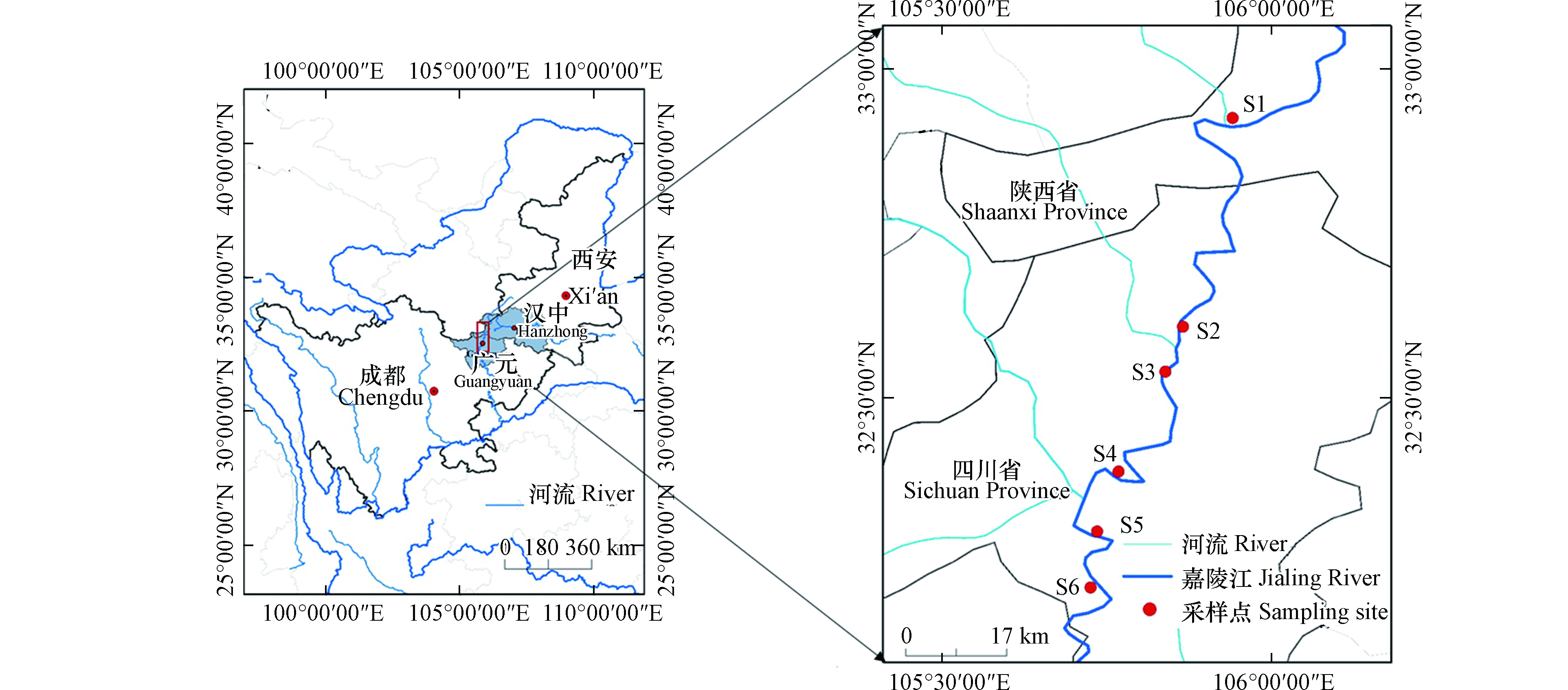
 下载:
下载:




